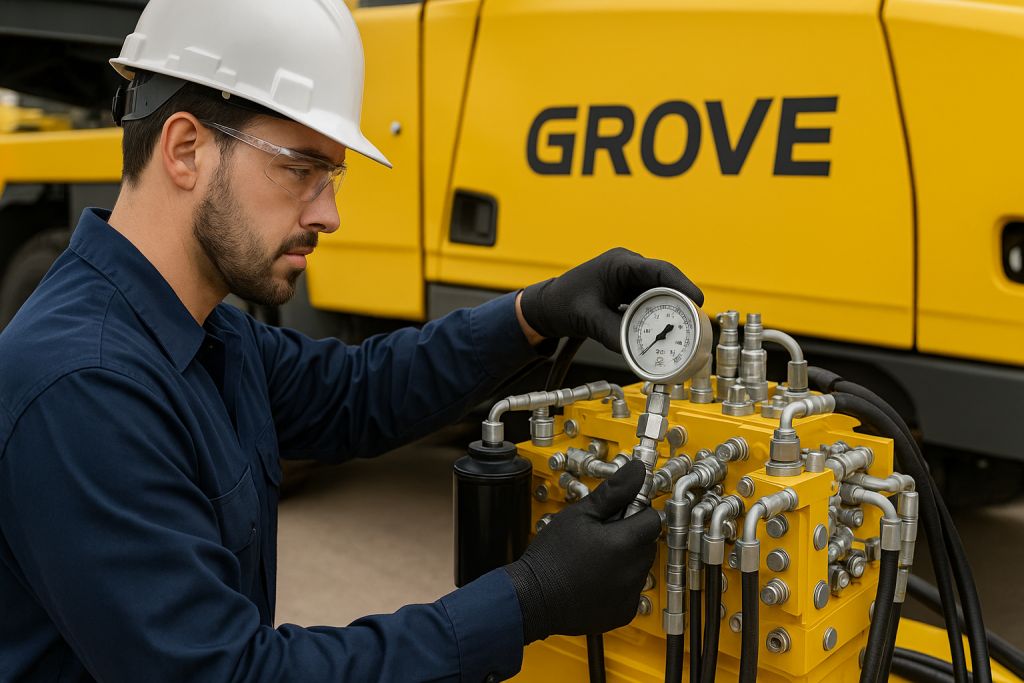
Hydraulic systems are the core of Grove cranes, powering the critical functions that make these machines vital for heavy-duty tasks. From lifting massive loads to deploying outriggers, hydraulics drive every major operation. A failure in this system can stop a project in its tracks, highlighting the importance of understanding the key Grove crane parts and maintaining them diligently. Selecting a reliable crane parts supplier is equally critical to ensure operational efficiency and safety.
Core Hydraulic System Components
The hydraulic system in a Grove crane comprises several vital components: pumps, cylinders, hoses, valves, and filters. Each part plays a specific role, and a failure in one can disrupt the entire system.
The pump is the system’s engine, circulating hydraulic fluid under high pressure to drive crane operations. Whether handling light or heavy loads, a Grove crane pump must deliver steady performance. Wear on internal components can reduce efficiency, strain other parts, and lead to unexpected downtime.
Cylinders convert fluid pressure into mechanical motion, enabling movements like boom extension or outrigger stabilization. Leaking seals in a cylinder can reduce lifting capacity and create unsafe conditions, making regular inspections essential.
Hoses and lines act as the system’s conduits, channeling high-pressure fluid across the crane. These flexible components endure constant stress, which can cause cracks or leaks over time. A burst hose can halt operations and release pressurized fluid, posing a safety hazard to workers.
Valves control the direction and flow of hydraulic fluid, ensuring precise crane operation. A faulty valve can cause erratic or delayed movements, which can disrupt work and increase safety risks on the job site.
Filters protect the system by removing contaminants like dirt, metal particles, and water from the hydraulic fluid. A neglected filter allows these impurities to circulate, accelerating wear on pumps, valves, and other components.
Why Maintenance Is Essential
Hydraulic system failures often start with small, detectable issues. A minor hose leak, a sticking valve, or a clogged filter may seem insignificant, but ignoring these signs can lead to major breakdowns. Regular maintenance is the key to catching problems early and avoiding costly repairs.
Hydraulic fluid, for instance, is highly sensitive to heat. Prolonged exposure to high temperatures degrades its viscosity, reducing lubrication and increasing wear on components like pumps and cylinders. Operators who notice sluggish performance, rising temperatures, or unusual noises can address these issues with a fluid change before they escalate into a full system failure.
Hoses are another frequent failure point. A small crack or bulge often signals deeper damage to the internal reinforcement. Replacing a compromised hose promptly can prevent a catastrophic burst, which could require a complete system flush and significant downtime.
The Role of a Trusted Crane Parts Supplier
When a hydraulic component fails, the quality of the replacement part determines how quickly the crane returns to service. Grove crane parts are designed to meet exacting standards, ensuring compatibility and reliability. Using generic or low-quality alternatives can lead to premature failure, unpredictable performance, or safety hazards.
A reputable crane parts supplier provides more than just parts—they offer expertise and efficiency. They understand the specific requirements of Grove crane models, verify part compatibility, and maintain a robust inventory of common components like filters and hoses. For specialized parts, they can source them quickly, minimizing project delays.
Choosing an unreliable supplier can lead to incorrect parts, long wait times, or components that fail prematurely. A trusted supplier ensures fast, accurate deliveries, keeping your crane operational and your projects on track.
Practical Maintenance Strategies
Effective maintenance extends the life of a Grove crane’s hydraulic system. While scheduled servicing is essential, daily habits can prevent unexpected failures and improve performance.
Operators should be trained to recognize early warning signs, such as slow response times, unusual sounds, or inconsistent movements. For example, a winch that hesitates or a boom that drifts may indicate a hydraulic leak. Reporting these issues promptly can prevent minor problems from escalating.
Daily inspections are critical. Before each shift, operators should check hoses for wear, verify valve operation, and monitor fluid levels. Filters should be replaced on schedule to prevent contaminants from damaging the system. Keeping detailed maintenance records helps identify trends and address recurring issues proactively.
Fluid management is a priority. Always use the hydraulic oil recommended for your Grove crane model, as incorrect grades can cause overheating or seal damage. Store oil in clean, sealed containers to avoid contamination before it enters the system.
Safety and Regulatory Considerations
Hydraulic failures can create significant safety risks. A leaking cylinder may cause a load to shift unexpectedly, while a burst hose can spray hot fluid near workers. Malfunctioning valves can lead to sudden, uncontrolled movements, endangering operators and ground crews.
Regulatory agencies prioritize proper hydraulic maintenance. Maintaining detailed records of inspections, repairs, and the use of genuine Grove crane parts from a trusted crane parts supplier can demonstrate compliance during audits. Using substandard parts may save money upfront but increases liability risks if an incident occurs.
The Cost of Compromising on Quality
Opting for cheaper, non-genuine parts may seem like a way to save money, but it often leads to higher expenses in the long run. A low-quality filter may allow contaminants to damage pumps, while a substandard cylinder could fail prematurely. Each failure results in repair costs, downtime, and lost productivity.
Investing in genuine Grove crane parts and consistent maintenance reduces the total cost of ownership. Cranes experience fewer breakdowns, operate more efficiently, and remain in service longer. Over time, these benefits far outweigh the initial cost of high-quality components.
Conclusion
The hydraulic system is the heart of every Grove crane, enabling the precision and power that define these machines. Pumps, cylinders, hoses, valves, and filters must work seamlessly to ensure reliable performance. By prioritizing proactive maintenance, using genuine Grove crane parts, and partnering with a trusted crane parts supplier, operators and managers can keep their cranes safe, efficient, and productive. In the demanding world of heavy equipment, quality and diligence are essential for success.